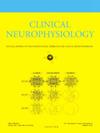高频振荡检测体外膜氧合患者急性脑损伤
IF 3.7
3区 医学
Q1 CLINICAL NEUROLOGY
引用次数: 0
摘要
目的利用HFO分析加强现有的SSEP模式,使其成为体外膜氧合(ECMO)患者急性脑损伤(ABI)检测的床边诊断工具。由于计算机断层扫描(CT)和磁共振成像(MRI)的复杂性,ECMO患者ABI的及时诊断具有挑战性。将时频分析整合到常规SSEP监测中,早期发现ABI有助于及时做出医疗决策。方法收集2016 - 2022年约翰霍普金斯重症监护病房(icu)连续SSEP数据,包括31例ECMO和45例非ECMO患者。根据临床指示,采用CT和MRI检测ABIs。利用小波技术,对SSEP-HFO的两个分量进行量化:HFOL (80-200 Hz)和HFOH (200-600 Hz),然后将其送入线性核支持向量机(SVM)。结果ABI患者(N = 22)表现为hoh抑制(中位数= - 9.09,四分位间距(IQR) = - 13.5;(N = 9,中位数= - 4.39,IQR = [- 6.35;−3.28]dB, P = 0.035)。SVM分类器检测ABI的准确率为75%,灵敏度为82%,优于SSEP-N20。结论ssep - hfo可提高ECMO患者床边ABI的早期发现。本文章由计算机程序翻译,如有差异,请以英文原文为准。
Using high-frequency oscillation to detect acute brain injury in extracorporeal membrane oxygenation supported patients
Objective
This study aims to utilize HFO analysis to enhance existing SSEP modality and develop it as a bedside diagnostic tool for acute brain injury (ABI) detection in Extracorporeal Membrane Oxygenation (ECMO) patients.
Significance
Timely diagnosis of ABI in ECMO patients is challenging due to logistical complexities with computed tomography (CT) and magnetic resonance imaging (MRI). Integrating time–frequency analysis into routine SSEP monitoring for early ABI detection can facilitate timely medical decisions.
Method
Consecutive SSEP data were collected from Johns Hopkins Intensive Care Units (ICUs), including 31 ECMO and 45 non-ECMO patients from 2016 to 2022. ABIs were determined using CT and MRI as clinically indicated. Using wavelet techniques, two SSEP-HFO components were quantified: HFOL (80–200 Hz) and HFOH (200–600 Hz), which were later fed to a Support Vector Machine (SVM) with a linear kernel.
Result
ECMO patients with ABI (N = 22) exhibited suppressed HFOH (Median = −9.09, Interquartile Range (IQR) = [ −13.5; −4.73] dB) compared to patients without (N = 9, Median = −4.39, IQR = [−6.35; −3.28] dB, P = 0.035). The SVM classifier achieved an accuracy of 75 % and a sensitivity of 82 % for detecting ABI, outperforming SSEP-N20.
Conclusion
SSEP-HFO can potentially improve early detection of ABI in ECMO patients at the bedside.
求助全文
通过发布文献求助,成功后即可免费获取论文全文。
去求助
来源期刊

Clinical Neurophysiology
医学-临床神经学
CiteScore
8.70
自引率
6.40%
发文量
932
审稿时长
59 days
期刊介绍:
As of January 1999, The journal Electroencephalography and Clinical Neurophysiology, and its two sections Electromyography and Motor Control and Evoked Potentials have amalgamated to become this journal - Clinical Neurophysiology.
Clinical Neurophysiology is the official journal of the International Federation of Clinical Neurophysiology, the Brazilian Society of Clinical Neurophysiology, the Czech Society of Clinical Neurophysiology, the Italian Clinical Neurophysiology Society and the International Society of Intraoperative Neurophysiology.The journal is dedicated to fostering research and disseminating information on all aspects of both normal and abnormal functioning of the nervous system. The key aim of the publication is to disseminate scholarly reports on the pathophysiology underlying diseases of the central and peripheral nervous system of human patients. Clinical trials that use neurophysiological measures to document change are encouraged, as are manuscripts reporting data on integrated neuroimaging of central nervous function including, but not limited to, functional MRI, MEG, EEG, PET and other neuroimaging modalities.
 求助内容:
求助内容: 应助结果提醒方式:
应助结果提醒方式:


